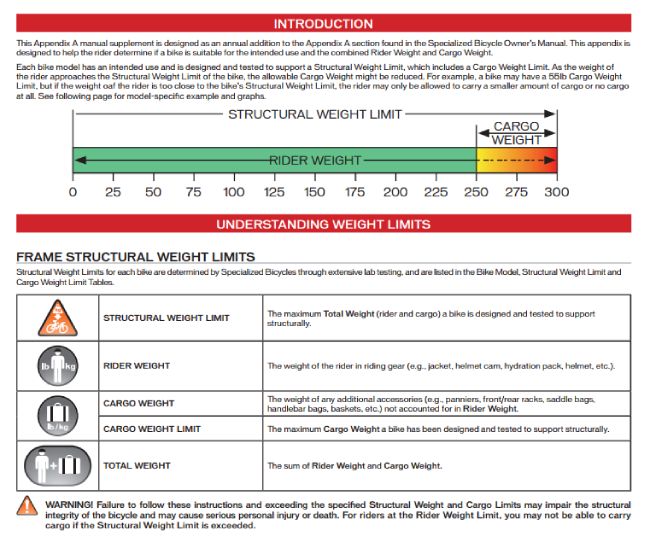Like any other vehicle, bikes also have a weight limit. How much weight your bicycle will be able to support depends on a number of factors.
Today, we’ll talk about those factors that influence your bike’s weight capacity, how to find the ideal weight limit yourself, and what to do if you have more weight to carry than your bike can handle.
What Is the Weight Limit of a Bike?
A standard adult bike usually can handle 250 to 300 lbs of weight, including the cargo.
Most road bikes have around 275 lbs of weight limit while a few around 300 lbs. In contrast, mountain bikes have a tolerance of 300 lbs.
However, there are a few manufacturers offering bikes that can hold up to 550 lbs.
Factors That Influence the Weight Limit of a Bike
1. Frame
Steel frames are cheap but super heavy and of low quality. Aluminum alloy is lighter and belongs to the mid-range category. On the other hand, the best frame materials are carbon and titanium that are super light yet long-lasting but they will cost you a fortune.
2. Wheel, rim and spoke
The wheels bear most of the stress and when they are affected, the rims and spokes are also affected.
The trick here is to choose a wheel with higher spoke. Bikes usually have 24 spokes but if you’re overweight, your ideal choice will be 32 or 36.
If your rim has 32 or 36 spokes then they’ll remain safe under heavy pressure while also protecting the inner tube. Similarly, a wider and deeper rim will provide better support.
3. Tires
The tires of a road bike are thin and narrow because they are designed for paved roads. You will find thicker tires among mountain bikes because they are designed for rocky terrain. No doubt these MTB tires have the better weight-handling capacity.
4. Steerer
In this case, avoid carbon and select alloy steerers because they have less risk of giving out.
5. Rim brake and disk brake
Rim brakes are strong enough to stop even the heaviest of riders if you can set them correctly but disk brakes will get our vote because they do not harm the wheel rim.
Disk brakes may be expensive but worth the cost.
6. Gear
Again, you should select a gear with a compact chainset. They have 52 teeth on the outer ring and 32 on the inner ring on the front. With this setup, even climbing uphill will be easier.
7. Additional/cargo weight
This will have a huge effect on your ride, so we will suggest reducing extra pounds from your body before you carry baggage, and this is healthy anyway! Many brands calculate the cargo weight separately but ultimately losing weight for extra baggage is the solution.
8. Your riding style and terrain
If you are overweight and ride only on smooth surfaces, your bike will last long whether it’s a road bike or a mountain bike. On the other hand, fast and frequent rides on rocky terrain will wear out the bike faster.
9. Suspense
Their job is to absorb the shock that in turn results in enhanced longevity. They are crucial for mountain bikes and most of the road bikes do not have them. Keep in mind that coil suspensions can hold weight better than air suspensions.
Do folding bikes have a weight limit?
Yes, the range is around 220-245 lbs. including the cargo. But there are a few brands that can hold up to 440 lbs.
Again, these are heavy bikes weighing 20-30 lbs. If overloaded, they may crack at the folding sections and they have a tendency to wear out sooner if frequently used on rough surfaces.
Do electric bikes have a weight limit?
Yes, they do. The weight limit for e-bikes is mostly around 220 to 300 lbs but some may tackle as much as 550 lbs.
Is there a standard measure to find the weight limit of a bike?
There is no standardized test that brands follow and every manufacturer has their individual claims for their products. In addition to that, brands that provide weight guidelines perform their own test and research.
How to find the right bike weight limit for yourself?
1) Check out the documents that come with your bike. Sadly only a few brands offer them.
2) Contact directly to the manufacturer
3) Get in touch with the local bike shops that can be of great help
Tip: You need to compare the weight limits of the components separately such as the frame, wheels, brakes, and others.
As said before, large and reputed manufacturers research and test their products in their own facilities. So, if they are saying a specific model can tolerate 300 lbs of weight, you can easily trust them with 315 lbs at least.
How to know if you’ve exceeded the limit?
- Noticeable change or damage on the seat post or it has fallen out of position
- Difficulty moving the fork because the suspension is locked
- Tires are over-compressed
- Deformation or crack in the rim
- Spokes are bent and broken








